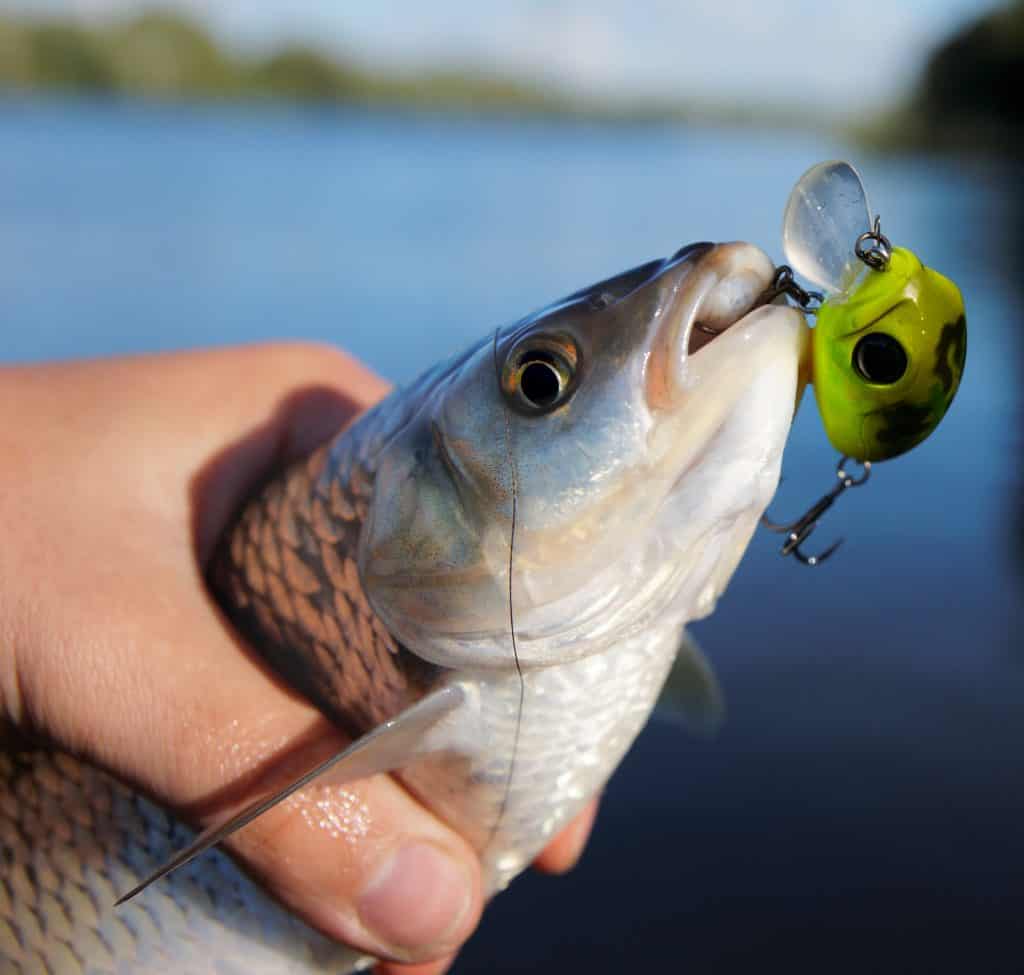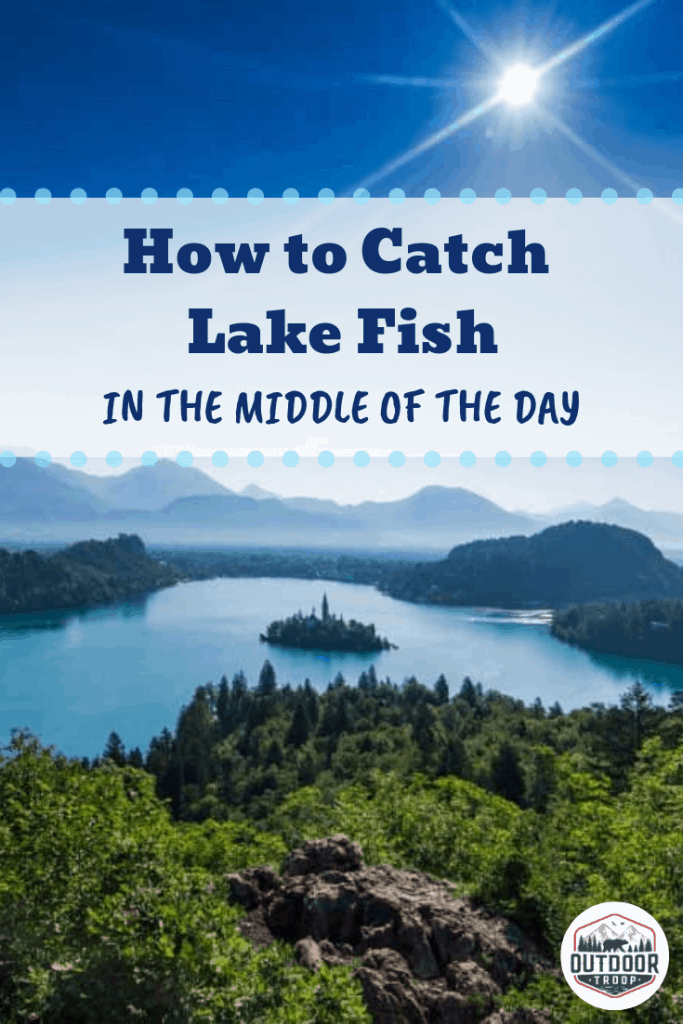
Lake fishing has many benefits, and its easier than you think. Lakes are usually stocked with fish if they’re separated from rivers and other water systems. Lakes that are naturally stocked have fish as well.
But how are these fish caught? Trolling for fish during the day will usually require a deeper trolling depth, as will jigging. Lake fishing, especially when targeting the middle parts, is usually done in a boat or kayak. Use lighter colored lures and baits so that the fish will be able to see them from the darker depths.
Lake fishing, like any type of fishing, depends on the fish you’re looking for. The vehicle which you fish in can slightly change the styles, but mostly the deciding factor will be the species and time of day.
Lake Fishing During the Day
From trolling with lures or dropping a bobber and bait, there isn’t a set way that lake fishing can be done. Fish can be caught year-round at lakes, it’s just a matter of kissing up to the fish’s aesthetics. And believe me, fish are all about aesthetics.
While fishing in a lake, it is best to know if the lake is man-made or a natural lake. There is a different fishing style for each type of lake, even if the fish are the same inside. As a rule of thumb, fish will be more likely found deeper in the water as the day progresses.
In the middle of the day, most of the fish, especially the bigger fish, will be in very deep water, depending on how deep the lake is.
Man-made Lakes – Focus your efforts around the drop-offs on the bottom of the lake. There will be fish looking for food there, and a hungry fish will be more likely to bite your hook. During the day, the fish will be deeper in the lakes, so go deep around the drop-offs
As a rule of thumb, fish will be more likely found deeper in the water as the day progresses.
Use plastics to work the bottoms, and crankbaits are good for getting to the deeper parts of the lake. Crankbaits can annoy the fish, too. This is sometimes beneficial because if the fish aren’t hungry or looking to eat, they will sometimes snap at the crankbaits or plastics, trying to get them away from themselves.
Most fish don’t eat during the day, so getting their attention in different ways is good.
Natural Lakes – Places that have any plants in or out of the water that can act as cover for fish will have a lot of fish around them. They will be more accessible near the shore, and can easily be fished from the banks. Because of the plants, it will be difficult to not get a lure snagged.
Try the weedless spoons, which can reduce snags to nearly zero.
Once the sun is high in the sky, the fish will retreat to darker waters. If the lake isn’t deep, they will retreat into these plants for the cover they provide. Drag your spoon or a different lure right above the plants. This will attract the fish out of the plants where your lures can reach.
Jigging can be difficult in water with a lot of plants, so be careful about losing your baits. Constantly check back on your hook if you feel a snag or if you think that you had a bite.
Boat Fishing During the Day
Having a boat is one of the biggest advantages a fisherman can have. The ability to choose exactly where s/he gets to fish can be what makes or breaks a fishing trip.
A motorized boat can help you get around a larger lake, while a kayak or canoe can help you slowly work an area. It is an amazing advantage to be able to have that choice.
Trolling
While in any type of water vehicle, the option to ‘troll’ is readily available. Trolling is the name given to dragging a line and hook through the water as you travel on your boat through the water. Especially with spin lures or different flashy lures, trolling can lead to great results.
When I go trolling on a boat, I bring 2-5 rods with me, depending on the laws of the area I’m fishing. I set them up on both sides of the boats, anchored down by rod holders, and watch them for a bite.
Trolling for salmon is easy and usually has great results, but there are a few things that go into successfully trolling.
Depth
Trolling should be done at the correct depth, which can change depending on the depth of the lake. Shoot for the depth where fish are swimming.
Most lakes deeper than 20 feet will have the fish around 20 feet. Anything shallower, and you should be able to see the fish. Gauge the optimum distance accordingly.
Remember: the fish will more likely be around 10-15 feet deeper in the water than the mornings or evenings. Drop your lines further down than you usually would. Not every fish will be deeper, but there is a higher chance that the hook will pass by more fish.
Speed
The speed you travel is crucial to trolling. If you go to fast, the fish might get spooked and not bite, or they might not have enough time to bite as the lure flashes by.
If you travel too slow, the lure could not work, depending on its type, and not attract any fish. Go around at different speeds until you find one that catches you the most fish.
The last variable that you should look out for is controlling your boat. Going in a straight line forever won’t work. Try increasing or decreasing your speed, just as you would when retrieving a lure. Turning from side to side can also get a fish on the hook faster as well.
Lures for the Daytime

At least once while fishing from the bank, it’s almost guaranteed that the thought, ‘Man I wish I could cast a little bit further to get my lure to that spot right there…’ will come up.
Every angler wishes there was a way to be able to stand exactly where they wanted without swimming because swimming and fishing do not work well together. Oh, wait. There is a way!
On a boat, you can get your lure anywhere. If you know how to fish from the banks, don’t do anything different on a boat with your lures. Cast them out, then drag them through the water towards you.
During the day when there is a lot of sunlight, use natural colored lures. Using greens that match the color of the plants in the water will help the fish not to get spooked.
Know which types of fish you are after before getting on the water in the daytime.
During days that are cloudy or just darker, use either very bright lures that will attract fish in the dim light, or use very dark lures that will stand out as a silhouette in the water. This will help the fish think that it is a bait-fish or a different kind of food and go in for the strike quicker.
The types of fish change with every location. Know which types of fish you should try for before getting on the water. Look online and research which kind of fish are in the lake you intend to fish in.
The government has websites for most major lakes, with a list of the species in each lake as well as any laws in place on the lake. If there isn’t a website, check the one of a lake close by. They’ll usually be similar.
| Fish | Lures |
| Bass | Summer/ Fall: Silver or Chrome Spring: Peach colored Plastics work great as well, Save any shredded plastic worms as well. |
| Trout | I’ve caught a lot of rainbows on a wedding ring lure. Size 3 Blue Fox spinners also do the trick. |
| Kokanee Salmon | Anything pink will grab the attention of the Kokanee. Pink spoon lures work well, as do the pink splatters from Amazon.com |
| Perch | Live bait is the best for perch, but I’ve seen some good results with the spinners from Bluefox and realistic crankbaits. |
Lures are an easy way to get a hook in the water without too much maintenance. Lures are reusable, but can still be a victim to snags, so be sure to bring more than just a few.
There’s not a worse feeling than having a day or trip cut short because you ran out of lures after just a few hours of fishing.
Daytime Bait Fishing
Live bait can sometimes get nasty, but anything for the fish, right? More aggressive fish love being able to attack a squirming insect.
The best bait that I’ve used while fishing a freshwater lake are minnows and worms, but there are a lot of good things to say about crickets. To most effectively use bait, patience is needed. Most of the fish that like bait will be deeper down.
Attaching split shot weights to the line can help get your baits down to the bottom, but they can also be somewhat inhibiting when trying to fish accurately and more horizontally. Split shots will swing back towards you unless they hit the bottom of the lake first.
The hook should be on a leader about 6 inches long after the lead weight.
The set up you should use is pretty easy to set up. From the bobber down, there should be around 18 to 20 inches of space that can be adjusted to deeper or shallower depths. After that space should be the lead weight.
The hook should be on a leader about 6 inches long after the lead weight. Use Powerbait or a different type of bait that will be slightly buoyant.
If there don’t seem to be any results, remove the bobber and increase the leader length to around 1’6″ or 2″. If the bait is buoyant enough, it will stop the bait from ever touching the ground and stop it from getting stuck.
There are a lot of ways to set up a rod with a bait set up, so do more research and try out ways that seem like they’ll work for the lake you’ll be fishing.
Kayak Fishing
The only difference between a kayak and a boat, when it comes to fishing, is how maneuverable it can be in smaller areas. With the kayak, work the banks around the lake. Look especially for places where the water is covered by something, be it a bridge or a half-fallen tree.
Fish like the cover, as it gets them away from the sunlight.
Another thing to look for is inlets or outlets. If the lake is not isolated, these places will be sure to have fish passing through. Work the shallows around, or drop a line in the center where it gets deeper.
All of the same rules apply with the lures and the bait, but don’t be shy to experiment with locations and lures until you find something that works for you.
Fly Fishing
Lakes, though not the first location that come to mind when fly fishing is mentioned, are still a great place to fly fish. Especially when trying for trout, flies have an advantage. Get flies from your local fish shop, or from the stores closer to where you decide to fish.
Eash fly is specially designed to mimic a certain insect that the fish enjoy eating. Local shops will have more of the types that local fish prefer to eat and will allow you to fool them into biting. Knowing exactly what the fish like to eat before starting can help you save money and can get you the best results.
Fly fishing locations are diverse. Trout, especially, usually hang around the plants that are the most green, the place where there will be the most food. Right before the drop off are the places where fish group together.
The time of day is a very important factor when fly fishing.
Fly fishing is a sport that has a lot to do with the gear. Waders are a good idea, but one that can get pretty expensive. Waders, a good pair, can cost anywhere from $100 to $300. They are waterproof pants and boots that can help keep water away from you, as you stand knee deep, or deeper, and fish.
Fly rods can also get kind of expensive. A cheap, but still quality rod, can land anywhere inside the range of $100 to $400. The expensive side of fly rods can get you somewhere around $1000 on Amazon.com, but can still get up to $5000.
The time of day is a very important factor when fly fishing. During most of your trips, you will probably have more success at the beginning of it, or closer to the end of your trip. The mornings and evenings are when the fish will be feeding and are more likely to bite.
Ice Fishing

Most winters, if it gets cold enough, the lakes will start to freeze over. The cover seems like it would stop fishing. Paired with the cold weather, that must be enough to stop professional anglers from fishing, right?
Wrong. If there’s water, anglers will put a hook in it. Ice fishing can be a very productive way of fishing. Ice covering the surface of the water acts as an extension of the bank, a pretty solid place to walk, as long as the ice is around 3 inches thick.
Once you reach a place on the river that seems like its a good place to fish, you’re going to want to pull out the ice auger you purchased before going out on the ice.
Amazon.com has a lot of good deals for hand ice augers, anywhere from $40 to $130. These are used to drill a hole in the ice. The smallest auger I’ve seen was 5-inches in diameter and was only $40, while the largest I’ve seen was a 12-inch motorized auger. The motorized augers range from $100 to $500.
Cloudless winter days can actually be colder. If you’re ice fishing on a bright, clear winter day, bundle up.
So you have your
But wait a minute. What’s on your line? Well, you have a choice. Once again, the best set up depends on the species of fish that you intend on catching. Ice fishing is usually best done with bait that smells strongly or looks/is authentic.
Minnows can catch a lot of fish looking for an easy meal, such as perch and bass. Worms and other bugs can be great bait for kokanee salmon or a cutthroat trout.
Lures also have a place in ice fishing. There are lures that look like real life fish. There are some pretty good ice fishing lures that work exceptionally well.
The Rapala Jigging Rap has a special place in my tackle box. This little jig has caught me more fish when ice fishing than any type of bait I’ve ever used before. Dropping it down into an ice hole and bouncing it up and down has brought me great results, especially kokanee, perch, and bass.
Ice fishing on lakes can be a lot of fun, but it can get cold very easily. Be prepared to be cold, or be prepared to keep in the heat. There are tents sold especially for ice fishing. They have an open bottom to expose the ice where the holes you drill are.
Fishing on lakes has a lot of great potential for great results, so be sure to be prepared as possible. Be sure to have all of the equipment that you need, but most importantly, be sure to have fun fishing. Good luck!
Related Questions
What time of day are bass most active? The best times of day to catch bass are during the early mornings and late evenings. These are the times when they will be more willing to come closer to the surface, as it will be less bright. They will start to feed around these times, too.
How should I fish if it is a hot, bright, day? Fishing with the current will allow you to interact with the most fish possible, as will using live bait. If you are comfortable with it, try fishing the night after a warm day. The fish will be more likely to be out near the banks after a hot, sunny day.

